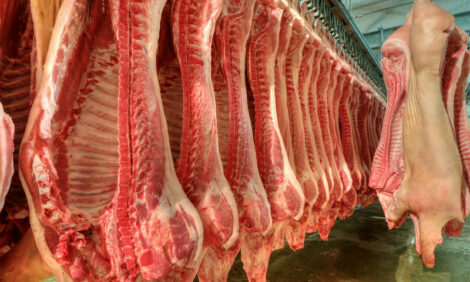



CME: Meat and Poultry Exports Surprisingly Strong
US - CME's Daily Livestock Report for 13 April 2009.NOTE: Our data for US pork and beef exports and exports of variety
meats of both species come direct form the Foreign Ag Service’s website. They
represent USDA’s product weight numbers for those categories. We have seen
other published data that differ from these, presumably because some other
items (sausage casings, fat, etc.) have been added in. At this point we have
chosen to stick with the actual muscle cut and variety meat data as reported by
USDA. We just wanted DLR readers to know why these data may be different
from others they have seen.
US meat and poultry exports were, in many observers’ eyes,
surprisingly strong in February. US beef exports were 11.1 per cent higher than
last year with South Korea being the big contributor to growth, increasing by
8,862 per cent (see Figure 1). That percentage increase, of course, was
from a number very near zero one year ago but the shipment volume of 28.2
million pounds was a major reason for year-on-year growth. The other major
contributor to beef export growth was Vietnam, which nearly doubled its year-todate
imports through February to become the fourth largest destination for US
beef. Shipments to Japan grew slightly from last year’s levels as shipments to
Mexico and Canada stand 15 per cent and 18 per cent smaller than last year, respectively.
One reason for that decline, of course, is that cattle imports from both of these
countries have been driven lower by mandatory country of origin labeling, leaving
more cattle available for domestic packers in Mexico and Canada, thus increasing
domestic production and supplanting US exports. The value of US
beef exports through February stands 10.8 per cent higher than last year with South
Korea and Vietnam accounting for nearly all of the growth in this item as well.
The value of shipments to Canada is down 23.4 per cent YTD.

US pork exports were 9.7 per cent smaller in February versus one year ago. That brought YTD pork exports down to 7.1 per cent lower than last year (see Figure 2) with China/Hong Kong (-68 per cent) and Russia (-51 per cent) the primary reasons for the reduction. Shipments to Mexico amounted to 44.04 million pounds product weight, 54 per cent higher than in 2008, and drove YTD exports to Mexico to +60.3 per cent. That in spite of a sharply devalued peso. YTD shipments to Japan are also up — 16.6 per cent — while Australia and Taiwan saw small unit gains. On the value side, US shipments through February have actually increased by 0.7 per cent with Japan (+33.5 per cent) and Mexico (+59.6 per cent) leading the way. Exports to Canada are down in both volume (10.5 per cent) and value (11.4 per cent) this year, in part due to higher Canadian pork production from MCOOL-reduced Canadian market hog imports.

The huge success story for pork in February was variety meats — up 54.3 per cent in volume and 52.5 per cent in value through February (Figures 3 and 4). While China/Hong Kong has been a disappointment on the meat side, they have been a boon on the by-product side, taking 32% more product and paying 47 per cent more dollars for it thus far in 2009. Mexico remains our largest pork variety meat market and has exhibited remarkable growth again this year.










